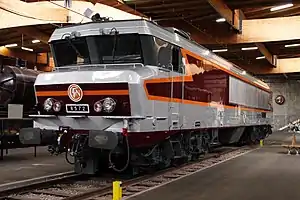SNCF Class CC 6500
The SNCF Class CC 6500 is a class of 1.5 kV DC electric locomotives. The CC 6500 was, together with the CC 40100 and diesel CC 72000, the first generation of the 'Nez Cassé' family of locomotives and designed for hauling express trains with speeds up to 200 km/h (124 mph) but also used for heavy freight trains. Among the trains they hauled in their first years of service were the SNCF flagship train Le Mistral and Trans Europ Express trains Aquitaine, Le Capitole and l'Étendard.[1]
| SNCF Class CC 6500 | |||||||||||||||||||||
|---|---|---|---|---|---|---|---|---|---|---|---|---|---|---|---|---|---|---|---|---|---|
 CC-6572 at Cité du Train de Mulhouse, Mulhouse, France | |||||||||||||||||||||
| |||||||||||||||||||||
| |||||||||||||||||||||
| |||||||||||||||||||||
| |||||||||||||||||||||
Technical details
The locomotives had 3-axle monomotor bogies with each set of 3 axles coupled by gears. Speed regulation was by rheostats and series-parallel control. The motors had double armatures so there were four "demi-motors" which allowed three motor groupings: full series, series-parallel and full parallel. The power controller had 28 steps.
The second batch of CC 6500 locomotives were equipped with third-rail electrical pickups for use on the steeply-graded Maurienne line in the Alps, which were removed when the line was converted to overhead catenary supplies.[2]
Production
Between 1969 and 1976 a total of 74 were built, with the last of this class taken out of service in 2007. Four more were built as dual-system 1.5 kV DC/25 kV AC locomotives, series CC21000. These were reconfigured for use as DC only locomotives between 1995 and 1996 , taking the total of CC6500 locomotives to 78.[2]
References
- Nock, O.S. (1978). "The Aquitaine: pioneer of electric power", in World Atlas of Railways, pp. 120–121. New York: Mayflower Books (original publisher: Artists House, London, UK). ISBN 0-8317-9500-X.
- Haydock, David; Fox, Peter (1999). French Railways: Locomotives and Multiple Units (4 ed.). Platform 5. p. 17. ISBN 1-872524-87-7.
Further reading
- Perren, Brian (April 1983). "Riding a French legend". Rail Enthusiast. EMAP National Publications. pp. 22–27. ISSN 0262-561X. OCLC 49957965.
| Wikimedia Commons has media related to SNCF Class CC 6500. |